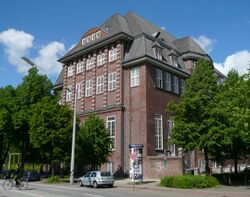University of Fine Arts of Hamburg
Topic: Organization
 From HandWiki - Reading time: 3 min
From HandWiki - Reading time: 3 min
 Main building | |
| Type | Public university |
|---|---|
| Established | 1767 |
| President | Martin Köttering |
| Students | 650 |
| Location | , |
| Website | hfbk-hamburg.de/en |
 | |
The Hochschule für bildende Künste Hamburg (HFBK Hamburg) is the University of Fine Arts in Hamburg. It dates to 1767, when it was called the Hamburger Gewerbeschule; later it became known as Landeskunstschule Hamburg. The main building, located in the Uhlenhorst quarter of Hamburg-Nord borough, was designed by architect Fritz Schumacher, and built between 1911 and 1913. In 1970, it was accredited as an artistic-scientific university.
History
The Hamburger Gewerbeschule (Hamburg Vocational School) was founded in 1767 by the Patriotische Gesellschaft (Patriotic Society). It was named the Staatliche Kunstgewerbeschule in 1896, later the Landeskunstschule (State School of Art). Fritz Schumacher designed the main building especially for the art school. Located at Am Lerchenfeld 2 in Uhlenhorst, a quarter of Hamburg-Nord, it was built between 1911 and 1913. After World War II, it re-opened as the Landeskunstschule by Friedrich Ahlers-Hestermann, who had previously been a professor at the Kölner Werkschulen (Cologne Academy of Fine Arts). He was succeeded by architect Gustav Hassenpflug, who changed the institution to the Hochschule für bildende Künste Hamburg. The school was accredited as a university in 1970.[1]
Introduction of tuition sparks protest
In July 2007, a scandal erupted when the university administration under Martin Köttering came under political pressure to expel students for having protested newly introduced tuition fees. Joerg Draeger and the Hamburg Senate, dominated by the Christian Democratic Union (CDU) demanded expulsion of more than half of the art students for having taken part in a tuition boycott. The scandal gained nationwide press coverage.[2] In June 2008, about 680 students were enrolled at HFBK Hamburg.
Stolpersteine
Two stolpersteine – memorials to victims of Nazism – have been laid for two faculty members. Friedrich Adler, who taught at the Kunstgewerbeschule from 1907 until his forced retirement in 1933, was killed in Auschwitz in 1942. Hugo Meier-Thur, who taught from 1910 to 1943, was killed at Fuhlsbüttel concentration camp in 1943.[3]
Notable faculty members
- Jutta Koether, painting
- Matt Mullican, multimedia
- Anselm Reyle, art
- Wim Wenders, film
- Adam Broomberg and Oliver Chanarin, photography
- Thomas Demand, sculpture
Notable former faculty members and alumni
- Fatih Akin, student 1994–2000, guest professor 2005–2006
- Uwe Bahnsen, student
- Esther Berlin-Joel, student
- Joseph Beuys, guest professor 1974
- Max Bill, professor 1967–1974
- Bernhard Blume, professor 1987–2011
- Hans Breder, student 1961-1964
- Woldemar Brinkmann, student
- Bazon Brock, professor 1965–1976
- Bruno Bruni, student 1960–1965
- John Burgan, guest professor 2002
- Bernhard Cella, student
- Bastian Clevé student 1971–1976
- Carl Otto Czeschka, professor 1907–1943
- Hanne Darboven, student 1962–1965, honorary professor 2000–2009
- Isa Genzken, student 1969–1977
- Gotthard Graubner, professor 1969-
- Erich Hartmann
- Rudolf Hausner, professor
- Oliver Hirschbiegel
- Rebecca Horn, student 1963/1964–1970
- Francesco Mariotti, student 1965 – 1969
- Alfred Hrdlicka, professor 1973–1975
- Friedensreich Hundertwasser, professor 1959
- Alfonso Hüppi
- Horst Janssen, student 1946–1951
- Isaac Julien, professor 2006
- Martin Kippenberger, student 1972–1976
- Vlado Kristl
- Wolfgang Lauenstein, student
- "Loriot" (Vicco von Bülow), student 1947–1949
- Alfred Mahlau
- Gerhard Marcks, 1945–1950
- Jonathan Meese, student 1993–1998
- Holger Meins, student 1962–1966
- Herbert Niebling, student 1930's
- Albert Oehlen, student 1981–?
- Sigmar Polke, professor
- Hans Jürgen Press, student 1948–?
- Astrid Proll, student
- Dieter Rams, professor 1981−1997
- Daniel Richter
- Helke Sander, professor 1981–2003
- Edwin Scharff
- Eran Schaerf, professor
- Thomas Scheibitz
- Nicolaus Schmidt, student
- Paul Schneider-Esleben, professor 1961–1972
- Santiago Sierra, student 1989–1991
- Cornelia Sollfrank, student 1990–1994
- Annegret Soltau, studentin 1967–1972
- Carl Vogel, professor 1962–1989, president 1976–1989
- Otto Waalkes, student 1970–??
- Paul Wallat, student 1899–1902
- Paul Wunderlich, professor 1963–1968
- Yüksel Yavuz, student
References
- ↑ "HFBK History". HFBK Hamburg. http://www.hfbk-hamburg.de/en/art-academy/en-history-hfbk/. Retrieved 20 December 2014.
- ↑ "Kunst als Protest" (in German). Die Zeit. http://www.zeit.de/online/2007/28/bg-hfbk-protest. Retrieved 22 January 2012.
- ↑ "Stolpersteine vor der Kunsthochschule. Gedenkfeier am Lerchenfeld." In: Hohenfelder und Uhlenhorster Rundschau, No. 3/2009, p. 14
External links
- Official website
- Hochschule für Bildende Künste Hamburg eastchance.com
- Hochschule für bildende Künste Hamburg wissenschaft.hamburg.de (in German)
- Hochschule für bildende Künste Hamburg Das Bildungs- und Studenten-Portal (in German)
- Hochschule für bildende Künste Hamburg kulturkarte.de (in German)
[ ⚑ ] 53°34′3″N 10°1′53″E / 53.5675°N 10.03139°E
 KSF
KSF